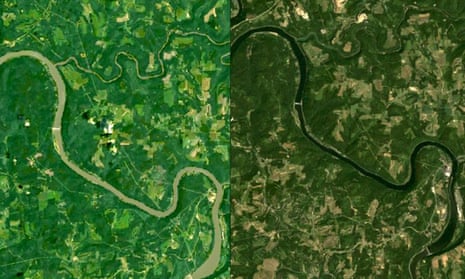Rivers may seem like immutable features of the landscape but they are in fact changing color over time, a new study has found.
Researchers compiled a database of satellite images of major rivers in the United States from 1984 to 2018 and learned that about a third have significantly changed color in less than 40 years.
The overall significance of the changes are unclear and could reflect various ways in which humans are impacting the environment, said lead author John Gardner, an assistant professor of geology and environmental science at the University of Pittsburgh.
One stark example from the study of rapid color change is Lake Mead along the Colorado River. Because water levels have declined since the early 2000s owing to drought and increased water demand, the water’s color has gone from a blue and green hue to a yellower river. The Double Mountain Fork Brazos River in Texas, on the other hand, went from yellow to blue and green after a dam was built in the early 90s.
Some color shifts reflected a seasonal trend – the lower Mississippi River area had steady seasonal color changes.
“We saw that rivers downstream of dams had river color patterns that likely mirrored dam operations, and long-term trends in river color that were caused by shrinking reservoirs and proximity to large cities,” Gardner said.
“Rivers – comparatively to other ecosystems – are super degraded since they drain our landscapes,” he added. “We use them heavily for all sorts of things for drinking water and transportation.”
Legislation like the Clean Water Act has improved water quality in the United States these past 40 years, said Gaboury Benoit, a Yale School of Environment Professor who was not involved with the research. He pointed out that water color isn’t always an indicator of declining water quality, because it can also reflect an improvement in cases where fewer industrial or agricultural byproducts are entering the water, and that the study “rightfully does not draw conclusions.”
“Stricter enforcement of parts of the Clean Water Act are helping to reduce pollution coming from urban land use,” he said in an email. “What remains problematic is agriculture, which has enjoyed exemption from many water quality regulations.”
Environmental justice experts say that changing river colors can be cause for alarm. In Maryland, Patuxent River advocate Frederick Tutman said the waterway was currently a murky brown color, but when he was a child the river was green.
Reports on the river’s condition have attribute the pollution to a growing population and wastewater treatment facilities in the Patuxent watershed. Maryland residents have also worried that a military base along the river could have contributed to the darker shade.
Tutman recalled the Flint water crisis as an example of how water color can indicate water quality issues. In an effort to save money, officials stopped using Lake Huron and began to rely on the polluted Flint River for the city’s water supply. Residents reported murky yellow or brown water coming out of their faucets and eventually began citing health problems like hair loss and rashes after drinking the water and using it to bathe.
“You can find ‘Flints’ across America, where poor people have nobody at all paying attention to the quality of their drinking water or the surface waters nearby,” he said.
He did note that in many ways water quality has improved across the country.
“In the 60s we had burning rivers,” he said. “We don’t have burning rivers any more.”
